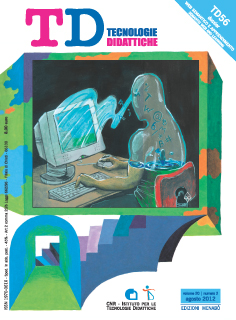Uso dei semantic Wiki a supporto dell'apprendimento collaborativo
Contenuto principale dell'articolo
Abstract
Dettagli dell'articolo
Gli autori che pubblicano su questa rivista accettano le seguenti condizioni:
- Gli autori mantengono i diritti sulla loro opera e cedono alla rivista il diritto di prima pubblicazione dell'opera, contemporaneamente licenziata sotto una Licenza Creative Commons CC BY 4.0 Attribution 4.0 International License.
- Gli autori possono aderire ad altri accordi di licenza non esclusiva per la distribuzione della versione dell'opera pubblicata (es. depositarla in un archivio istituzionale o pubblicarla in una monografia), a patto di indicare che la prima pubblicazione è avvenuta su questa rivista.
- Gli autori possono diffondere la loro opera online (es. in repository istituzionali o nel loro sito web) prima e durante il processo di submission, poiché può portare a scambi produttivi e aumentare le citazioni dell'opera pubblicata (Vedi The effect of Open Access).
Riferimenti bibliografici
Alvino S., Bocconi S., Boytchev P., Earp J., Sarti L. (2009). Sharing digital resources in teacher education: an ontology- based approach. In D. Dicheva, R. Nikolov e E. Stefanova (eds.). Proceedings of 1st International Conference on Software, Services & Semantic Technologies. Sofia, Bulgaria: Demetra EOOD, pp. 52-59. http://www.openaire.eu/bitstream/10867/37/1/S3T2009 _ 1_SAlvino_StBocconi_PBoytchev_JEarp_LSarti.pdf (ultima consultazione 07/03/2012).
Aroyo L., Dicheva D. (2004). The New Challenges for E-learning: The Educational Semantic Web. Educational Technology & Society. 7 (4), pp. 59-69.
Ausubel D. (1963). The psychology of meaningful verbal learning. New York: Grune & Stratton.
Bianchi S., Vercelli G., Vivanet G. (2010). Digital Libraries and Educational Resources: the AquaRing Semantic Approach. International Journal of Emerging Technologies in Learning, iJET. 5 (1), pp. 11-15. http://online-journals.org/i-jet/issue/view/79 (ultima consultazione 07/03/2012).
Bruner J. (1996). The Culture of Education. Harvard University Press.
Calvani A. (1998). Costruttivismo, progettazione didattica e tecnologie. In D. Bramanti (ed.). Progettazione formativa e valutazione. Roma: Carocci Editore.
Coccoli M., Maresca P., Stanganelli L. (2010). Enforcing team cooperation: an example of Computer Supported Collaborative Learning in Software Engineering. In Proceedings of the 16th International Conference on Distributed Multimedia System. International Workshop on Distance Education Technologies, DMS-DET 2010 (Chicago, IL, U.S.A., 14-16 ottobre 2010), pp. 189-192.
Coccoli M., Maresca P., Stanganelli L. (2011). Computer Supported Collaborative Learning in Software Engineering. In Proceedings of the 16th IEEE Global Engineering Education Conference - Learning Environments and Ecosystems in Engineering Education (Amman, Jordan, 4-6 aprile 2011). IEEE/IEL, VDE Verlag Conference Proc., pp. 990-995. http://www.psut.edu.jo/sites/EDUCON/program/contribution1408_ b.pdf (ultima consultazione 07/03/2012).
Collins A.M., Loftus E.F. (1975). A spreading activation theory of semantic memory. Psychological Review. 82, pp. 407-428.
Craik F.I.M., Lockhart R.S. (1972). Levels of processing: A framework for memory research. Journal of Verbal Learning & Verbal Behavior. 11 (6), 671-684.
Gaeta M., Orciuoli F., Ritrovato P. (2009). Advanced ontology management system for personalised e-Learning. Knowledge Based Systems. 22 (4), pp. 292-301.
Gazzaniga M., Ivry R., Mangun G. (2005). Neuroscienze cognitive. Bologna, Zanichelli.
Gervasoni M.,Ventura M., Vercelli G., Vivanet G. (2009). Social Semantic Web & Folksontologie: prospettive didattiche. In Atti VI Congresso Sie-L, Università degli Studi di Salerno (Salerno, 16-18 Settembre 2009). http://www.elearninglab.eu/publications/SIEL09_e.PDF (ultima consultazione 07/03/2012).
Likert R. (1932). A technique for the measurement of attitudes. Archives of Psychology. 140, pp.1–55.
Novak J.D., Cañas A.J. (2006). The theory underlying concept maps and how to construct them. Technical Report IHMC CmapTools 2006, Florida Institute for Human and Machine Cognition.
Sampson D.G., Lytras M.D., Wagner G., Diaz P. (2004). Ontologies and the Semantic Web for E-learning. Educational Technology & Society, 7 (4), pp.26-28.
Schaffert S., Bischof D., Buerger T., Gruber A., Hilzensauer W., Schaffert S. (2006). Learning with Semantic Wikis. Proceedings of the First Workshop on Semantic Wikis. From Wiki To Semantics. (SemWiki 2006), (Budva, Montenegro, 11-14 giugno, 2006), pp. 109-123.
Shadbolt N., Hall W., Berners-Lee T. (2006). The Semantic Web Revisited. Intelligent Systems, IEEE. 21 (3), pp. 96- 101.
Siemens G. (2005). Connectivism: a learning theory for the digital age. International Journal of Instructional Technology & Distance Learning, 2 (1), pp. 3-10.
Spiro R.J., Coulson R.L., Feltovich P.J., Anderson D. (1988). Cognitive flexibility theory: advanced knowledge acquisition in ill-structured domains. In V.Patel (ed.). Proceedings of the 10th Annual Conference of the Cognitive Science Society. Hillsdale, NJ: Erlbaum.
Tizzi E. (1996). Insegnamento e apprendimento. In M. Gennari (ed.). Didattica generale. Milano: R.C.S. Libri e Grandi Opere S.p.A, pp. 53-100.
Tulving E. (1984). Multiple learning and memory systems. In K.M.J. Lagerspetz, P. Niemi (eds.). Psychology in the 1990’s. North-Holland: Elsevier Science Publishers B.V., pp. 163-184.
Vivanet G. (2011). Fondamenti per una teoria dell’apprendimento semantico. In T. Minerva, L. Colazzo (eds.). Atti VIII Congresso Sie-L 2011 (Reggio Emilia, 14-16 settembre 2011). http://www.siel2011.it/phocadownload/atti-siel2011.pdf (ultima consultazione 07/03/2012).
Vygotskij L.S. (1978). Mind in society: development of higher psychological processes. Cambridge, MA: Harvard University Press.
Wenger E. (1998). Communities of practice. Learning, meaning, and identity. Cambridge University Press.

